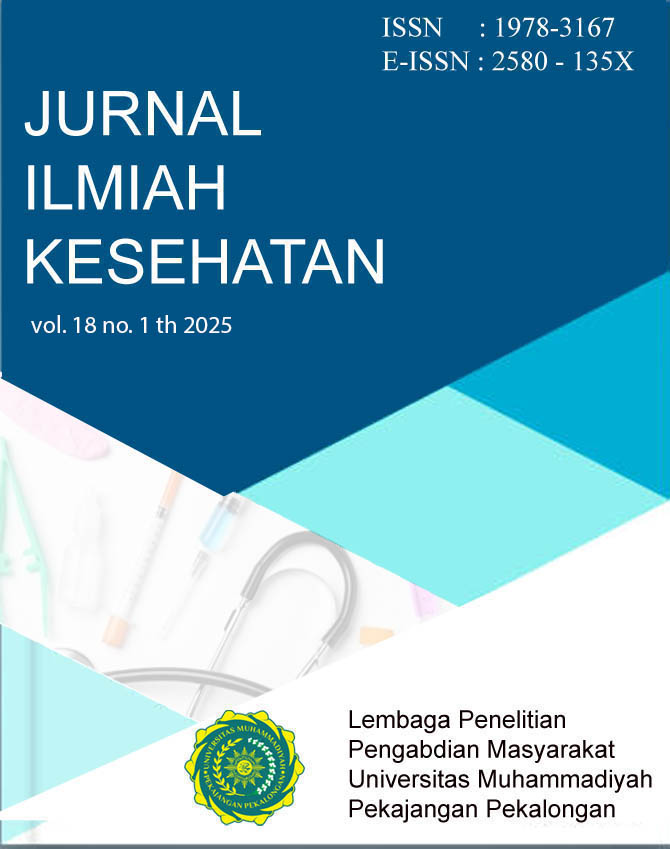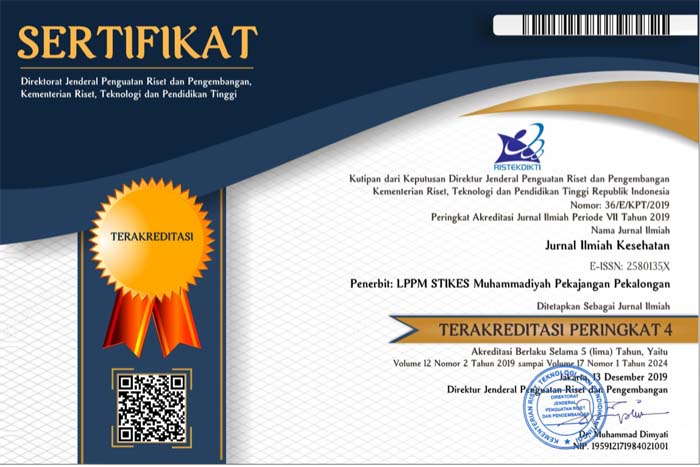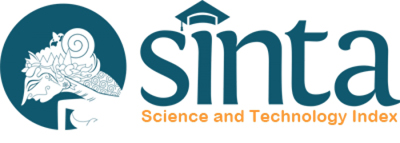Hubungan Antara Maternal Fetal Attachment (MFA) Dengan Pola Kesehatan Kehamilan
DOI:
https://doi.org/10.48144/jiks.v18i1.2018Keywords:
Maternal-Fetal Attachment, Health Practices, PregnancyAbstract
Health practices during pregnancy, such as smoking, consuming alcohol, or failing to meet nutritional requirements, can have serious impacts on the health of both the mother and fetus. These risks include premature labor, spontaneous abortion, anemia, and other dangerous complications. Additionally, insufficient ANC (Antenatal Care) visits can hinder the early detection of danger signs or pregnancy complications, such as anemia, preeclampsia, or maternal abnormalities, which could potentially endanger the birthing process. Maternal-fetal attachment (MFA) is an important factor that can significantly influence health practices, subsequently impacting the health and well-being of both pregnant women and their unborn fetuses. This study aimed to determine the relationship between maternal-fetal attachment and health practices during pregnancy at PMB Anisa Mauliddina. The research utilized quantitative descriptive analytical design with cross-sectional approach. The study was conducted at the Amanah Husada Clinic in Gunung Kidul Regency, involving 86 third-trimester pregnant women selected through purposive sampling. The results showed no significant relationship between maternal-fetal attachment and health practices during pregnancy at PMB Anisa Mauliddina, with a p-value of 0,084. In conclusion, this study found no correlation between maternal-fetal attachment and health practices during pregnancy at PMB Anisa Mauliddina.
References
T. Hadian, S. Moosavi, S. Meedya, S. Mohammad-Alizadeh-Charandabi, E. Mohammadi, and M. Mirghafourvand, “Relationship of health practices with depression and maternal-fetal attachment in adolescent pregnant women: A prospective study,” Arch. Psychiatr. Nurs., vol. 35, no. 5, pp. 465–471, 2021, doi: 10.1016/j.apnu.2021.06.011.
S. Astuti, A. I. Susanti, and R. Elista, “Gambaran Paparan Asap Rokok Pada Ibu Hamil Berdasarkan Usia Kehamilan Di Desa Cintamulya Kecamatan Jatinangor Kabupaten Sumedang,” J. Sist. Kesehat., vol. 2, no. 1, pp. 22–27, 2016, doi: 10.24198/jsk.v2i1.10413.
K. R. Fitriana, “Effects of Alcohol Consumption and Smoking in Pregnant Women,” Jiksh, vol. 10, no. 2, pp. 233–237, 2019, doi: 10.35816/jiskh.v10i2.159.
P. F. Ludin, R. C. L. Wulandari, and A. Meiranny, “Kepatuhan Ibu Hamil dalam Mengonsumsi Tablet Fe : Literature Review,” Media Publ. Promosi Kesehat. Indones., vol. 6, no. 10, pp. 1933–1939, 2023, doi: 10.56338/mppki.v6i10.3850.
Kemenkes RI, “Pentingnya Pemeriksaan Kehamilan (ANC) di Fasilitas Kesehatan.”
WHO, “World Health Statistics 2019.”
Kemenkes RI, “Angka Kematian Ibu di Indonesia Tahun 2023,” 2023.
Dinkes Sleman, “Tingkatkan Kesehatan Ibu dan Bayi, Wabup Sleman Luncurkan Buku Pedoman Rujukan Maternal Neonatal Kabupaten Sleman 2023.”
N. T. Sjariati and L. Primana, “Persepsi Dukungan Keluarga Terhadap Kelekatan Ibu Dan Janin,” J. Psychol. Sci. Prof., vol. 4, no. 3, p. 154, 2021, doi: 10.24198/jpsp.v4i3.24973.
E. K. Suryaningsih, M. L. Gau, and Wantonoro, “Concept analysis of maternal-fetal attachment,” Belitung Nurs. J., vol. 6, no. 5, pp. 157–164, 2020, doi: 10.33546/bnj.1194.
Kemenkes RI, “Permenkes No 21 tahun 2021,” Pap. Knowl. . Towar. a Media Hist. Doc., vol. 5, no. 2, pp. 40–51, 2021.
E. K. Suryaningsih, “Indonesian Version of Prenatal Attachment Inventory (PAI): A Preliminary Stud,” National Taipei University of Nursing and Health Sciences, 2015. [Online]. Available: https://scholar.google.com/scholar?cluster=1185667826852180591&hl=en&oi=scholarr
Ustunsoz, Guvenc, Akyuz, and Oflaz, “Comparison of maternal-and paternal-fetal attachment in Turkish couples,” Midwifery, vol. 26, p. el-e9, 2010.
N. Baghdari, E. Sadeghi Sahebzad, M. Kheirkhah, and E. Azmoude, “The Effects of Pregnancy-Adaptation Training on Maternal-Fetal Attachment and Adaptation in Pregnant Women With a History of Baby Loss,” Nurs. Midwifery Stud., vol. 5, no. 2, 2016, doi: 10.17795/nmsjournal28949.
E. Abasi, H. Tahmasebi, and M. Zafari, “Assessment on effective factors of maternal-fetal attachment in pregnant women,” pp. 68–75, 2012.
N. M. M. Hassan and F. M. A. E. Hassan, “Predictors of Maternal Fetal Attachment among Pregnant Women,” IOSR J. Nurs. Heal. Sci., vol. 6, no. 1, pp. 95–106, 2017, doi: 10.9790/1959-06010695106.
E. Abasi, M. Tafazzoli, H. Esmaily, and H. Hasanabadi, “The effect of maternal-fetal attachment education on maternal mental health,” Turkish J. Med. Sci., vol. 43, no. 5, pp. 815–820, 2013, doi: 10.3906/sag-1204-97.
L. J. Muglia, K. Benhalima, S. Tong, and S. Ozanne, “Maternal factors during pregnancy influencing maternal, fetal, and childhood outcomes,” BMC Med., vol. 20, no. 1, pp. 1–5, 2022, doi: 10.1186/s12916-022-02632-6.
E. Abasi, A. Keramat, N. S. Borghei, S. Goli, and M. Farjamfar, “Evaluating the effect of prenatal interventions on maternal–foetal attachment: A systematic review and meta-analysis,” Nurs. Open, vol. 8, no. 1, pp. 4–16, 2021, doi: 10.1002/nop2.648.
J. L. Alhusen, J. Blaustein, M. J. Hayat, L. Rose, P. W. Sharps, and J. Hopkins, “The Role of Mental Health on Maternal-Fetal Attachment in Low- Income Women postdoctoral fellow in mental health and psychiatric nursing,” J Obs. Gynecol Neonatal Nurs, vol. 41, no. 6, pp. 71–81, 2012, doi: 10.1111/j.1552-6909.2012.01385.x.The.
Fallon, Groves, Halford, and Bennett, “Maternal mental health and maternal-fetal attachment : A systematic review,” BMC Psychol., vol. 2, pp. 1–15, 2023.
Cannella, “Maternal mental helth and prenatal attachment: The importance of erly intervention,” Front. Psychol., vol. 1, no. 14, pp. 202–215, 2022.
Almeida and Costa, “Maternal behaviors during pregnancy and their impact on health outcomes: Acomprehensive review,” J. Matern. Helath Stud., vol. 3, no. 12, pp. 245–256, 2023.
Smith, Jones, and Carter, “Barriers to maternal helath behaviors during pregnancy: A systematic Review,” Matern. Child Health J., vol. 1, no. 27, pp. 56–71, 2022.
Kim, Lee, and Park, “The effectiveness of community-based prenatal education programs in promoting maternal health behaviors,” BMC Public Health, vol. 7, no. 23, pp. 102–115, 2023.












